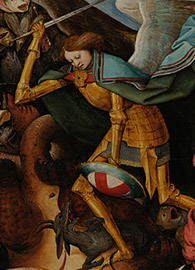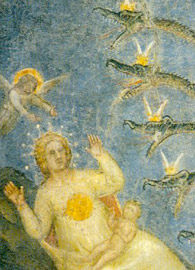Revelation Week 7
God’s Victory Already Realized in Heaven (Revelation 12:1–17)
By Rob Wall
Seattle Pacific University Paul T. Walls Professor of Scripture and Wesleyan Studies
Read this week’s Scripture: Revelation 12:1–17
18:57

 Enlarge
Enlarge
Take a couple of deep breaths! We have traveled wide and far through this visionary world over the last couple weeks. The risen Jesus commanded John to write down the revelation that would disclose the past, present, and future history of God’s restoration of all creation (Revelation 1:19). John envisions salvation’s past as a scroll held by the sovereign Creator that documents plans for a new creation (5:1), which God’s Lamb takes and opens one seal at a time, thereby beginning the last days when what our faithful God promises Israel according to Scripture comes to realization first in heaven and then on earth (6:11–11:19). The images of devastation occasioned by the unfolding of the scroll depict God’s decisive judgment of sin, the result of the Lamb’s death.
Salvation: Already But Not Yet
I’m active in a program of physical fitness called Crossfit. I began Crossfit several years ago to become a fitter person for old age. Most realize that participation in only one Crossfit workout will leave you closer to death than to a healthier life! It takes time. Real fitness results from weekly workouts continued over many months. But the benefits I’ve already gained herald a future fitness not yet fully realized.
Revelation’s narrative of God’s salvation is plotted by a similar tension between the already but not yet. While John’s vision helps us imagine that the Lamb has already ended sin’s reign, we also note that human existence remains largely unchanged, and unrepentant sin still remains on earth (9:20–21). God’s victory because of God’s Christ, announced by trumpet fanfare (11:15–18), yields a salutary result in heaven where the Lord God Almighty is worshiped and God’s triumph over the destroyers of earth is celebrated; but God’s victory is not yet fully experienced on earth. Yes, the heavenly temple where the ark and presence of a covenant-keeping God is fully on display (11:19) is now open for the business of salvation. But the martyrs’ poignant refrain, “How long?” (6:10), may now be applied to creation’s experience of God’s past judgment of evil on the cross: when will we experience God’s victory over wickedness on earth as it is in heaven? “Soon”, “for the time is near,” (1:1, 3) the prophet promises. Hold on to God with all your heart, being, strength, and mind in the meantime.
John’s vision of salvation’s future will be written soon enough. But first the “Then” that opens Revelation 12 marks a new beginning and cast of characters. This is a vision about the present moment of God’s salvation, but from ground level. If the constant chants of God’s victory reverberate through heaven’s throne room, Christ’s sacrifice for creation’s salvation has a somewhat different result on earth: a spiritual war ensues between God’s people and an unholy trinity that rules over God’s opposition on earth.
A Woman Gives Birth to a Son
First comes a flashback that refocuses the reader on the climax of Scripture’s story of God’s salvation. This passage is found at the pivot point of Revelation because it is the pivot point of human history. John envisions the story of Christmas, which marks the real beginning of history’s last days. The gospel narratives of the Messiah’s birth (Matthew 1–2; Luke 1–2) are plotted as a familiar conflict between the forces of evil (i.e., Herod, Rome) and God. [Author’s Note 1] Here too a pregnant woman is now in labor (Revelation 12:2) and about to give birth to a son (12:4–5), but is threatened by “a great fiery red dragon” (12:3) that intends to “devour her child” (12:4).
John records this scene as heaven’s way of signaling earth (12:1). The elaborate description of the pregnant woman tells nothing of her real identity. Frankly, the two most common interpretations of this woman — that she is either Mary or Eve — make little sense of this context. The personal stories of neither match the woman’s characterization in 12:6, 13–16. More likely this woman is the figuration of a community. Other entire communities, both for and against God, are personified in Revelation by female characters (14:4; 17:18; 21:9–10), as is the case here. The child of a pregnant woman could symbolize a people living within another people, as Isaiah imagined the deliverance of Judah (see Isaiah 26:17; cf. 66:7–8). In any case the grand entrance of this stunning woman, dressed in the sun, standing on the moon, and wearing a crown of twelve stars, would seem to suggest that she stands in for God’s faithful people (Israel and Church; see Revelation 12:17), which birthed and then nurtured God’s Messiah for the salvation of the world. [Author’s Note 2]
The agony she experiences giving birth may represent the heroic suffering of Israel’s faithful remnant that carried God’s promises forward from the exile (Micah 5:3; cf. Hebrews 11:29–40) as well as the earliest community of Christ’s followers (for whom John writes), many of whom were martyred for their faithfulness (cf. Revelation 2:8–11; 3:7–13; 6:9–11; 14:1–5). Revelation has already made clear that faithfulness to God’s redemptive purposes comes at a steep price; however, the wider Johannine tradition, which includes the letters of John, makes it equally clear that ultimately “the evil one cannot touch” God’s children (1 John 5:18).
This is an incredible promise since the portrait of the evil one presents an awe-imposing figure: a serpent of a fiery red “power” color, seven heads with a crown on each, and a vast tail that takes down a third of the sky’s stars. This dragon has other names: “the old snake, who is called the devil and Satan, the deceiver of the whole world” (Revelation 12:9). It is the party of God’s opposition, which certainly offers stiff competition for creation’s destiny. For this reason the clipped way John reports the woman “gave birth to a son [who] was snatched up to God” (12:5) creates an impression that underscores the gospel’s thematic: evil, no matter how imposing and powerful it may be, does not accomplish its malevolent purpose. [Author’s Note 3] God has won the battle and, so it would seem, without much fuss or foment on God’s part. The Messiah is born to rule the nations (see 11:15), the dragon doesn’t devour the child, and once finished with salvation’s work, the child is snatched back to God. One and done.
The Dragon is Relegated to Earth

 Enlarge
Enlarge
The woman’s flight to the desert place God has prepared for her allows her (i.e., God’s people) to take refuge for the forty-two months allotted God’s enemies — under the first beast’s earthly rule (see 13:5) — to trample down the redemptive prospects of the unbelieving community (see 11:1–2). Christ’s death ends Satan’s capacity to accuse God’s people (12:10), whatever influence this may have had on God’s providential care of the covenant community (see Job’s story); but Satan is granted authority to deceive the world (12:9; cf. Daniel 7:25) — that is, by asserting that evil is good or that God is not good. Once again, John envisions a clear and sharp divide between the believing and unbelieving communities, and the influence the powers and principalities of evil have on each. Drawing upon Paul’s vivid imagination, a people’s faithfulness to God wraps them in “the full armor of God” so that they can “extinguish the flaming arrows of the evil one” (Ephesians 6:13–17).
The child’s return to heaven, clearly referring to the risen Jesus’ exaltation, occasions a territorial war concerning whether the evil one and its angels should have a place left in heaven (Revelation 12:8). The next cast member introduced into John’s visionary narrative is the archangel Michael who represents God’s people in heaven’s war between good and evil (12:7; cf. Daniel 10:13, 21; 12:1). We already know who wins: “now the salvation and power and kingdom of our God, and the authority of his Christ have come” (Revelation 12:10). Corresponding to the victory of God’s Lamb over sin (12:11), then, Michael defeats the evil dragon and its army.
But there is a price to pay: the dragon’s occupation of heaven, where it accuses “our brothers and sisters […] day and night before our God” (12:10; cf. Job 1–2; Zechariah 3:1), ends and it gets tossed to earth. Here’s the price we pay: the dragon is seriously ticked off knowing he has only a short time to do mischief (Revelation 12:12), and mischief is what the evil one will do, as we will soon see. Clearly, however, the dragon’s rage is not a Hollywood motif of power, but of failure. Its inability to thwart God’s messianic plan of salvation (12:4–5) and corresponding defeat by Michael in heaven seals its fate. The dragon knows it’s a loser, and a sore loser at that!
The relationship between Christ’s death and the costly loyalty of his faithful followers unafraid to die is clear in the lyrics of this hymn. What is also made clear is the importance of this community’s fearless witness: God’s victory is forged by a partnership of the Lamb “and the word of their witness” (12:11). It is this solidarity of trust that exposes the evil one’s deception. It is an embodied (not spoken) word of witness, especially lived by the faithful martyrs, exemplified by the slaughtered Lamb, that underwrites the truth of the gospel: “now the salvation […] of our God [has] come” (12:10).
The prediction that the earth and sea will be the new headquarters of an awfully angry devil and its mischief elicits both heaven’s celebration but also the recognition that horrors are about to be visited upon earth (12:12). Since the devil makes his new address the “earth and sea” (12:12), their demise in the coming age is anticipated (see 21:1) when God’s fiercest enemies, evil and death, already defeated by the exalted Son, are then thoroughly destroyed (cf. 20:10–15). Gospel, people, gospel!
The Dragon’s War Against the Church
John’s vision returns to elaborate the earlier sighting of the woman who had fled to the wilderness, where God could care for her over an extended period of time (see 12:6). The devil’s immediate reaction once realizing its sudden defeat and exile to earth is to target and pursue the woman (i.e., God’s people; 12:13). The word the CEB translates as “chase” connotes the intention to persecute whomever is chased — a chase scene in which the bad guy pursues the heroine to harm her. As we would expect, however, the woman is protected from “the old snake” (12:9) at her desert refuge (12:14–17).
The woman’s transformation into a giant “eagle” to escape the devil’s grasp (12:14; cf. 12:6) recalls God’s description of Israel’s exodus from Egypt as a flight “on eagles’ wings” (Exodus 19:4). Escaping the devil’s deceptions (cf. Revelation 12:9) by “eagles’ wings” is a standard metaphor used of God’s rescue operations, whether by miraculous deliverance or by empowering God’s people to endure their trials (cf. Isaiah 40:31). The period of safety extended to the woman is again counted as “a time and times and half a time” (12:14) or “1,260 days” (12:6, since one “time” = one year according to John’s apocalyptic timetable). [Author’s Note 4]
The serpent attempts to drown the Church with a flood of deceptions from its mouth (12:15); they are the verbal attacks that ridicule and seek to marginalize Christian faith (cf. 1 Peter 4:4). One cannot help but think of today’s aggressive band of so-called “new atheists” who engage in name-calling and political tactics (rather than thoughtful discourse) to discredit the intelligence and morality of God’s people. It is creation (“earth”) itself that comes to the rescue by swallowing the river of deception that flows from the serpent’s mouth (12:16). While this image surely recalls the Creator’s use of nature to force the Pharaoh’s hand in rescuing Israel from Egypt, thereby fulfilling a promise made to Sarah and Abraham, perhaps it also suggests that God’s protection of the gospel’s proclamation against the attacks of God’s enemies results indirectly from evidence that a faithful people produces, which falsifies the serpent’s deceptions. After all, the dragon’s rage is directed not at God but at God’s people “who keep God’s commandments and hold firmly to the witness of Jesus” (12:17).
One last image in this passage that is easily missed carries forward a message for today’s Church. The dragon’s initial failure to defeat the woman only increases its resolve to take the battle to “the rest of her children” (12:17). A tension is provoked by this refrain. On the one hand, we hear the chorus celebrate the devil’s defeat in heaven and the securing of God’s eternal reign; we also hear its lamentation of coming horrors for God’s people on earth. But on the other hand, we are witnesses of the ineffectiveness of God’s enemies to win the ground war. But a ground war is often prolonged, and the woman’s children (That’s us, people!) are now engaged in the same spiritual and intellectual struggle that shaped our ancestors. The lyric of heaven’s chorus, sung loudly, is now the church’s battle song: “Now the salvation and power and kingdom of our God, and the authority of his Christ have come” (12:10).
Questions for Further Reflection
- It would seem unwise for any human to underestimate or discount Satan’s wiles, yet Revelation gives ample reason to purposefully live out God’s will without fear and trepidation. Consider three of these reasons not to stand in awe of Satan.
- How is faithful discipleship of Jesus costly in your life today? How are your prayers reflecting the knowledge of the ongoing spiritual struggle against God’s enemies?
<<Previous Lectio Back to Revelation Next Lectio>>

This work is licensed under a Creative Commons License.




